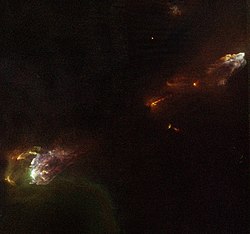

| Emission nebula | |
|---|---|
| Herbig–Haro object | |

Hubble Space Telescope WFC3 image of HH 1/2 and the jet pointing to HH 1 (right)
| |
| Observation data: J2000.0 epoch | |
| Right ascension | 05h36m 22.8s[1] |
| Declination | −06° 46′ 03″[1] |
| Distance | 1500[2] ly |
| Constellation | Orion[2] |
| Designations | HH 1-2, HH 1/2, HH 1, HH 2 |
| See also: Lists of nebulae | |
The Herbig-Haro objects HH 1/2 are the first such objects to be recognized as Herbig-Haro objects and were discovered by George Herbig and Guillermo Haro.[3][4][2][5] They are located at a distance of about 1343 light-years (412 parsec) in the constellation Orion near NGC 1999.[3] HH 1/2 are among the brightest Herbig-Haro objects in the sky and consist of a pair of oppositely oriented bow shocks, separated by 2.5 arcminutes (a projected separation of about 1.1 light year). The HH 1/2 pair were the first Herbig-Haro objects with detected proper motion[6] and HH 2 was the first Herbig-Haro object to be detected in x-rays.[7] Some of the structures in the Herbig-Haro Objects move with a speed of 400 km/s.[2]
The central region contains an opaque cloud core with an astrophysical jet[8] and a highly embedded multiple-star system that remains invisible below 3 Microns. These sources were first detected with the Very Large Array and are therefore named VLA 1 and 2.[9] The source HH 1-2 VLA 1[10] drives the HH 1/2 pair and the source VLA 2 drives the Herbig-Haro objects HH 144/145.[11] There might be even a third outflow in the central region of HH 1/2, indicating a third member.[12]
The jet towards HH 1 is visible in optical images, but the counterjet towards HH 2 was detected in the infrared with the Spitzer Space Telescope.[13]
|
| |||||||||||||
|---|---|---|---|---|---|---|---|---|---|---|---|---|---|
| |||||||||||||
| Stars |
| ||||||||||||
| |||||||||||||
| Star clusters |
| ||||||||||||
| Nebulae |
| ||||||||||||
| Galaxies |
| ||||||||||||
| |||||||||||||